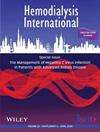Incidence of hospital admissions in bioimpedance-guided fluid management among maintenance hemodialysis patients—Results of a randomized controlled trial
Abstract
Introduction
Hemodialysis is life-sustaining in kidney failure. However, proper regulation of body fluids depends on an accurate estimate of target weight. This trial aims to compare clinical endpoints between target weight estimation guided by bioimpedance spectroscopy and usual care in hemodialysis patients.
Methods
This is an open-label, parallel-group, controlled trial that randomized, through a table of random numbers, adult patients on maintenance hemodialysis to target weight estimation based on monthly clinical evaluation alone or added to evaluation by bioimpedance twice a year. The primary outcome was survival, and the secondary outcomes were the rate of hospital admissions, change in blood pressure (BP), and antihypertensive drugs load. Participants were followed for 2 years. Survival analysis was performed using Kaplan–Meier estimator and Log-rank test, and hospital admissions were analyzed by the incidence-rate ratio.
Findings
One hundred and ten patients were randomized to the usual care (52) or bioimpedance (58) groups, with a mean age of 57.4 (15.4) years, 64 (58%) males. There was no difference between the groups at baseline. Survival was not significantly different between groups (log-rank test p = 0.68), but the trial was underpowered for this outcome. There was also no difference between the groups in the change in systolic or diastolic BP or in the number of antihypertensive drugs being used. The incidence rate of hospital admissions was 3.1 and 2.1 per person-year in usual care and bioimpedance groups, respectively, with a time-adjusted incidence rate ratio of 1.48 (95% CI: 1.20–1.82, p = 0.0001) and attributable fraction of risk among exposed individuals of 0.32 (95% CI: 0.17–0.45).
Discussion
The inclusion of bioimpedance data to guide the estimation of target weight in hemodialysis patients had no detectable impact on survival or BP control, but significantly reduced the incidence rate of hospital admissions.
The study was registered at ClinicalTrials.gov Identifier: NCT05272800.

 求助内容:
求助内容: 应助结果提醒方式:
应助结果提醒方式:


